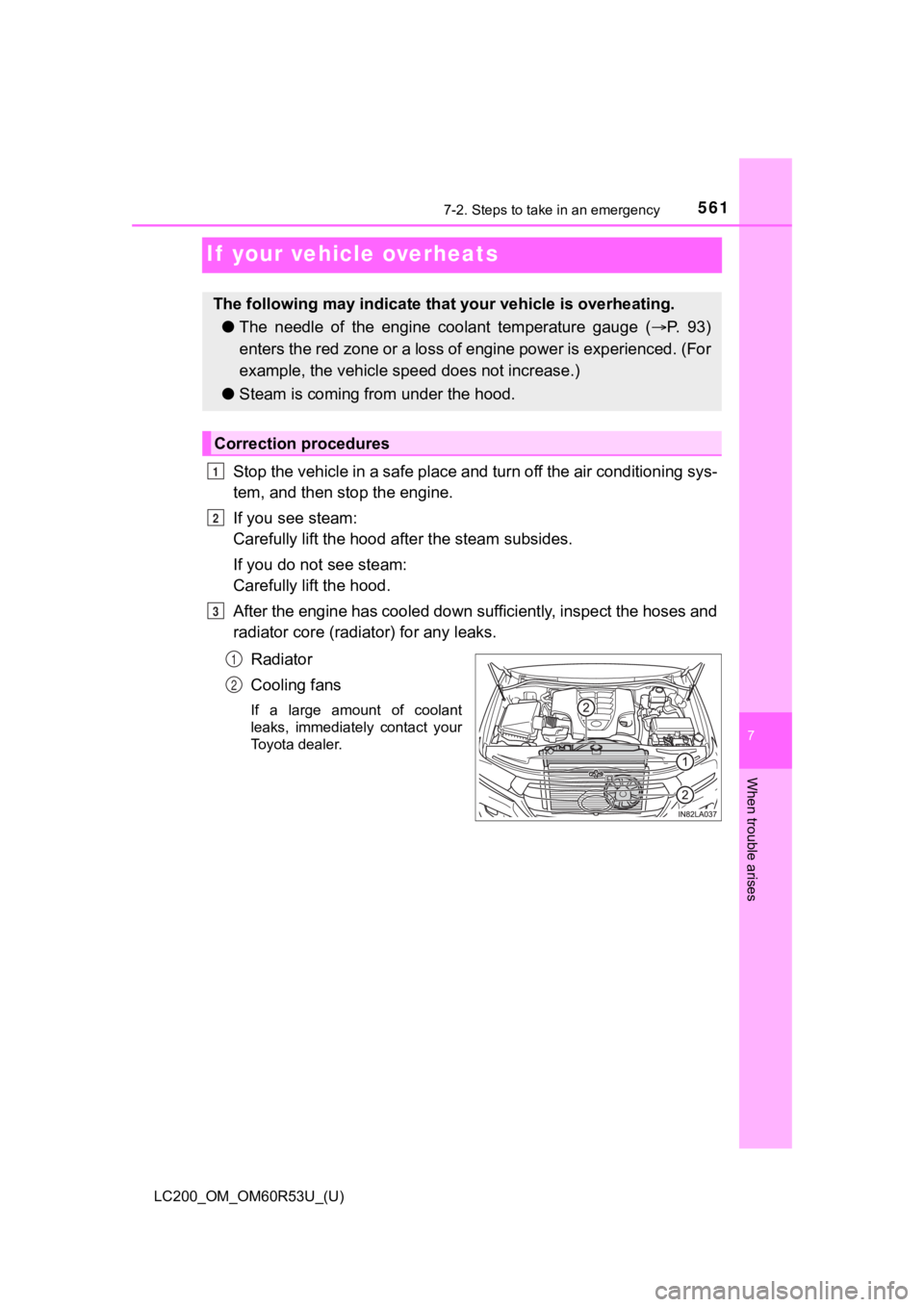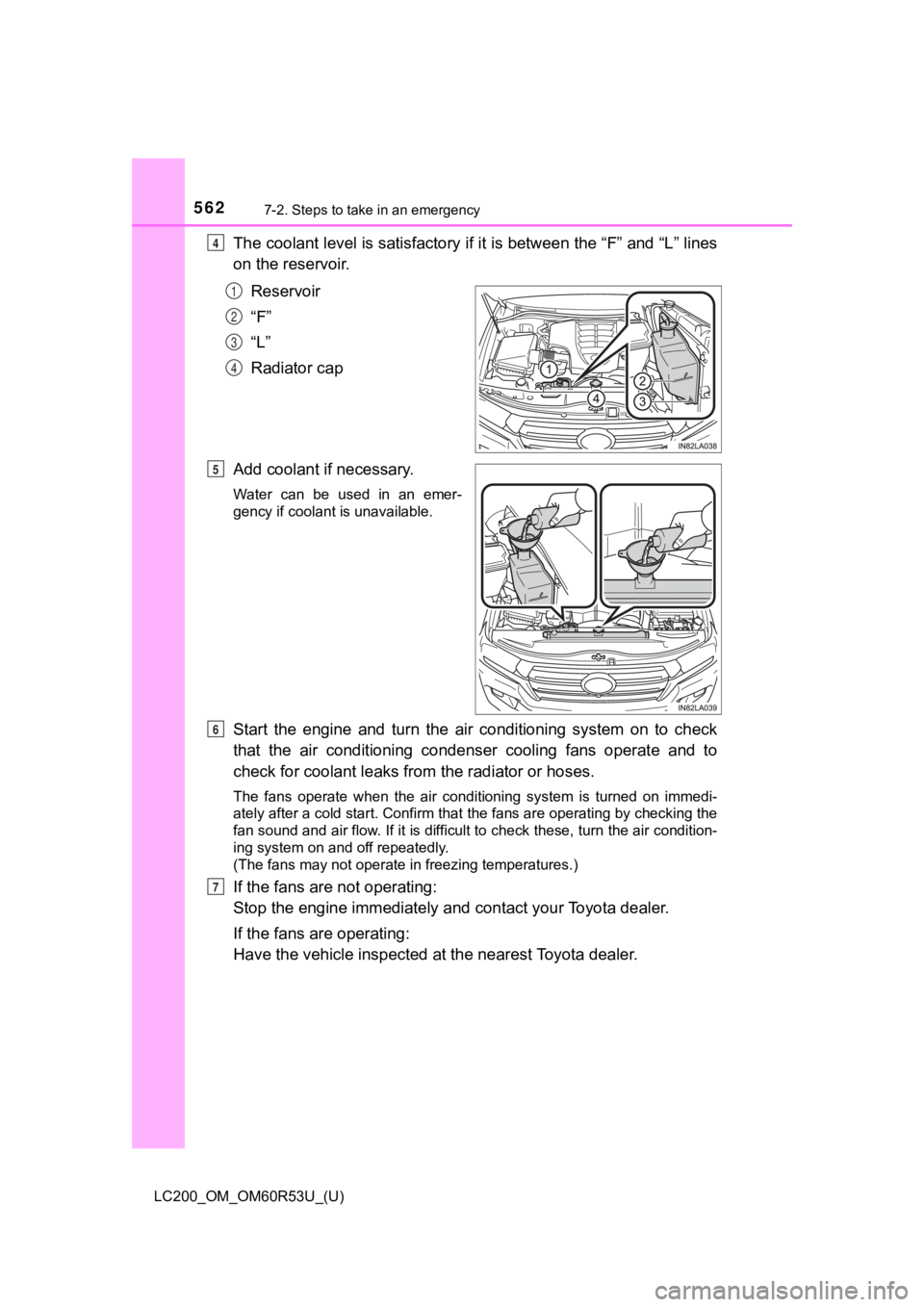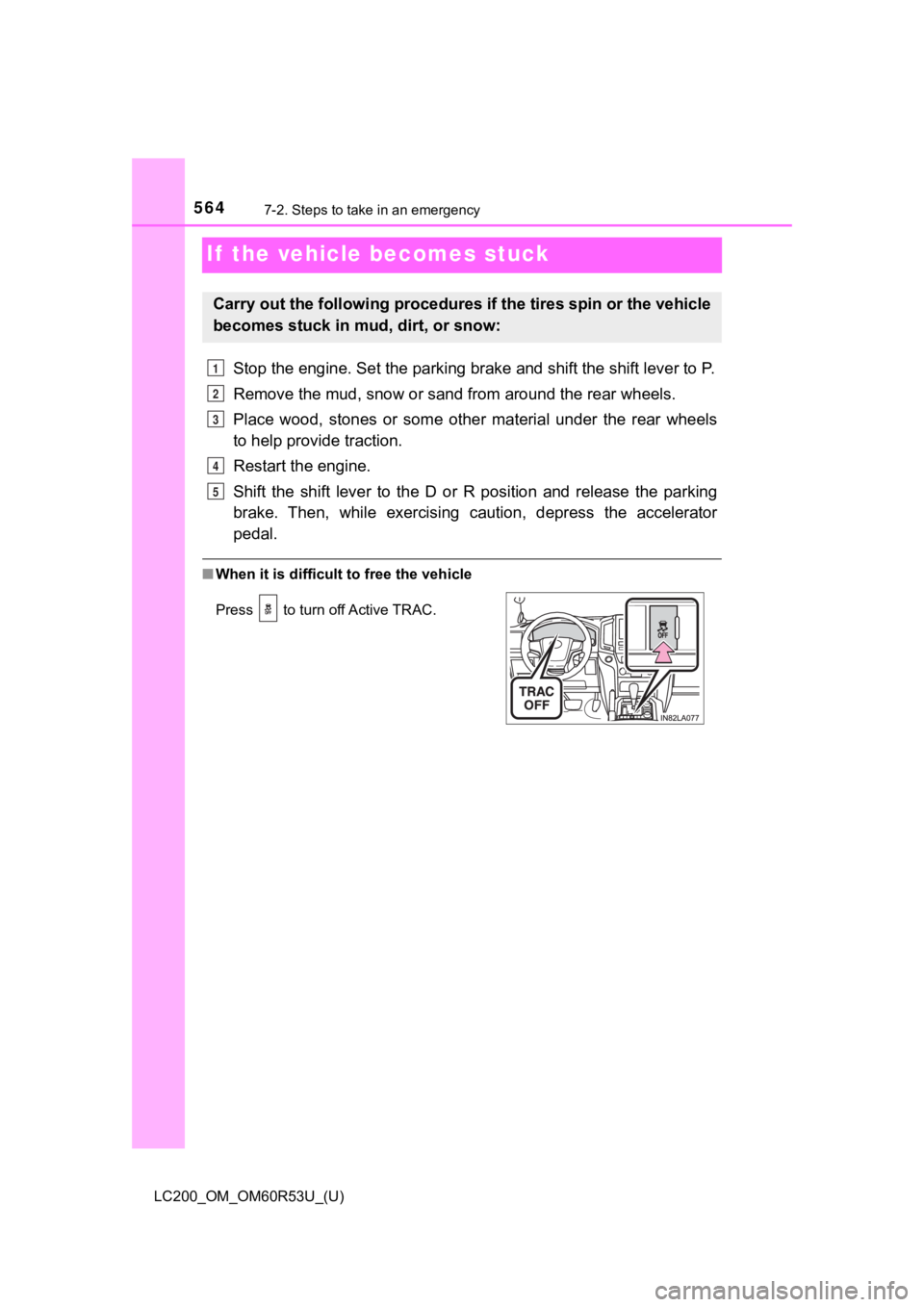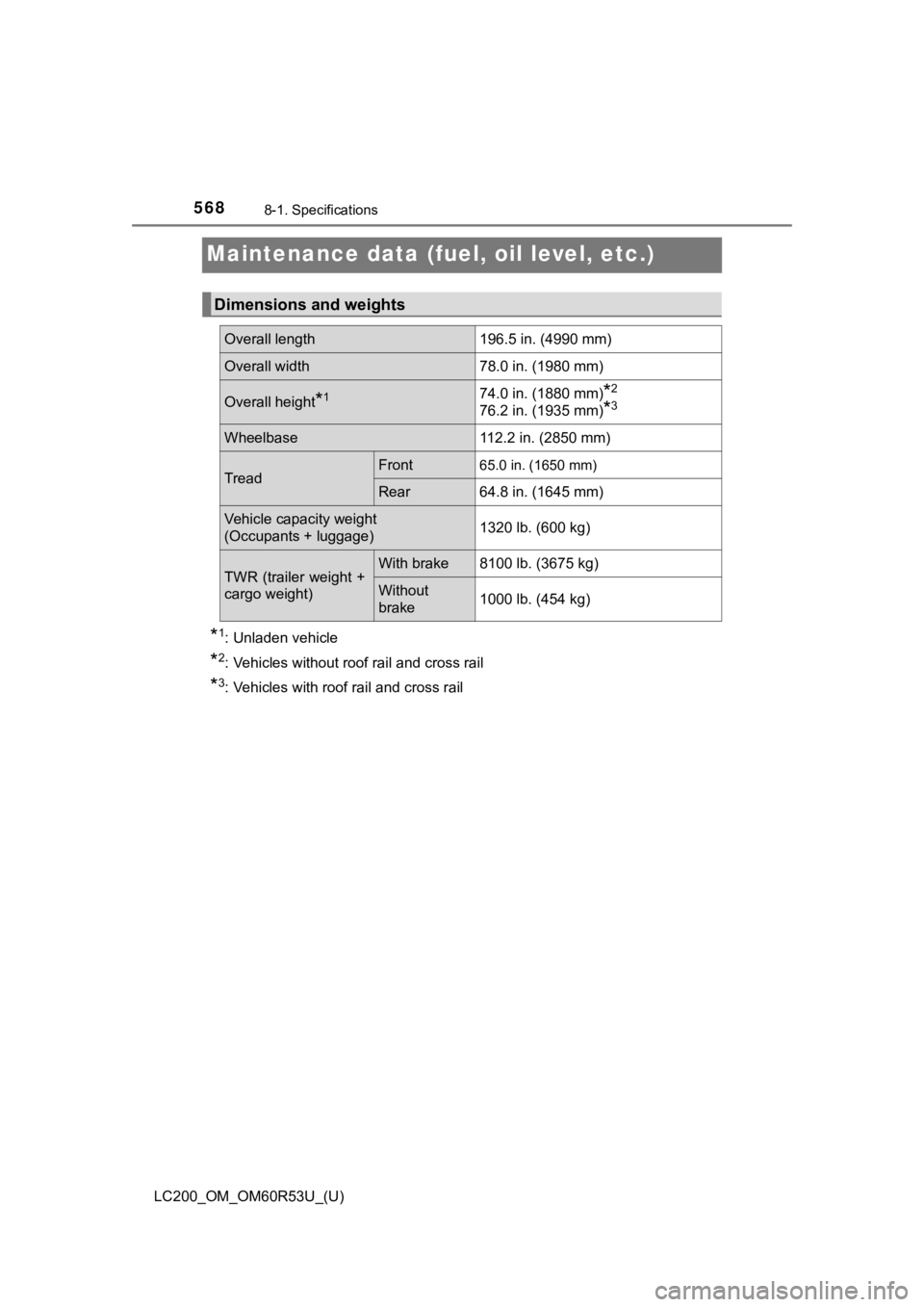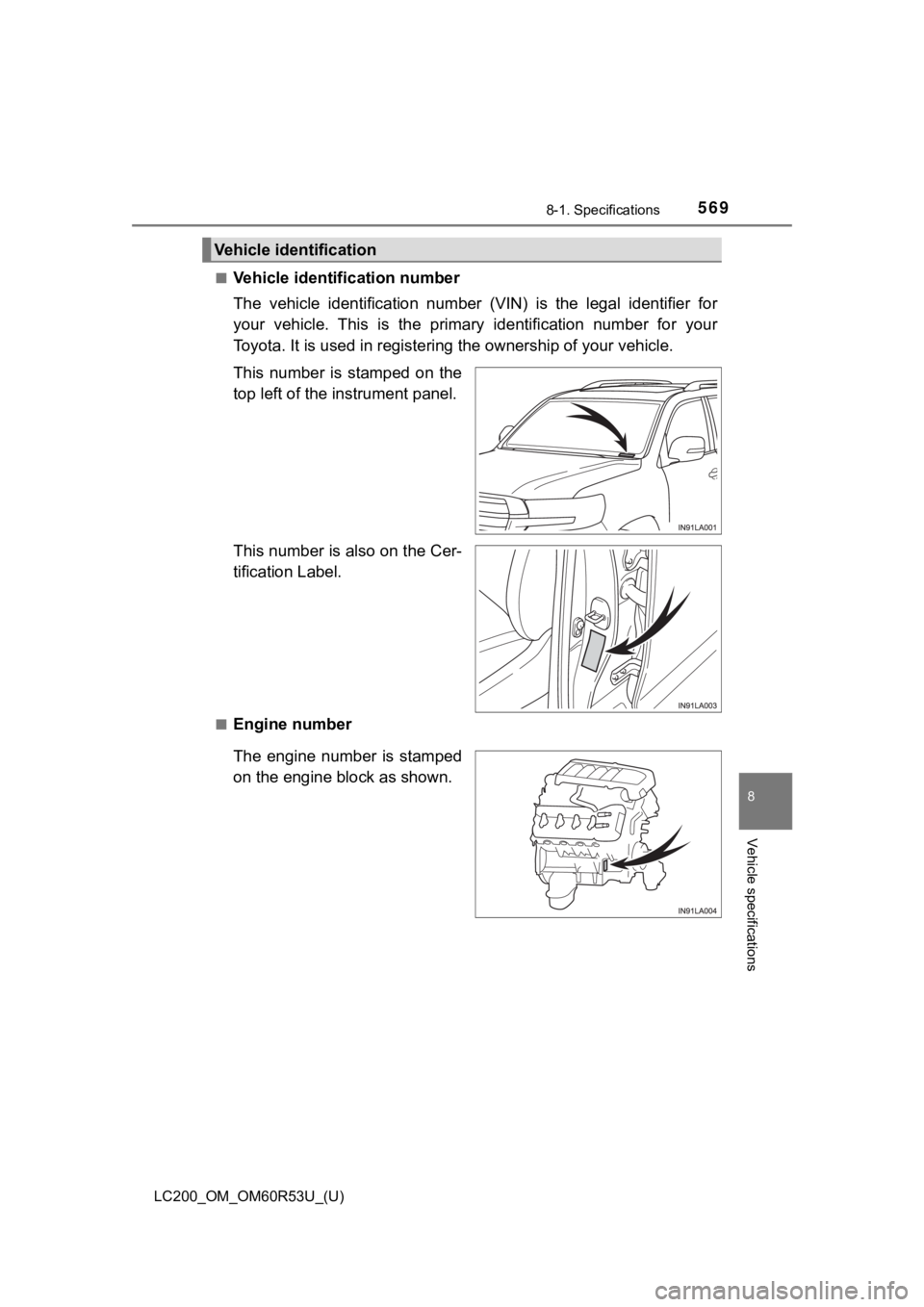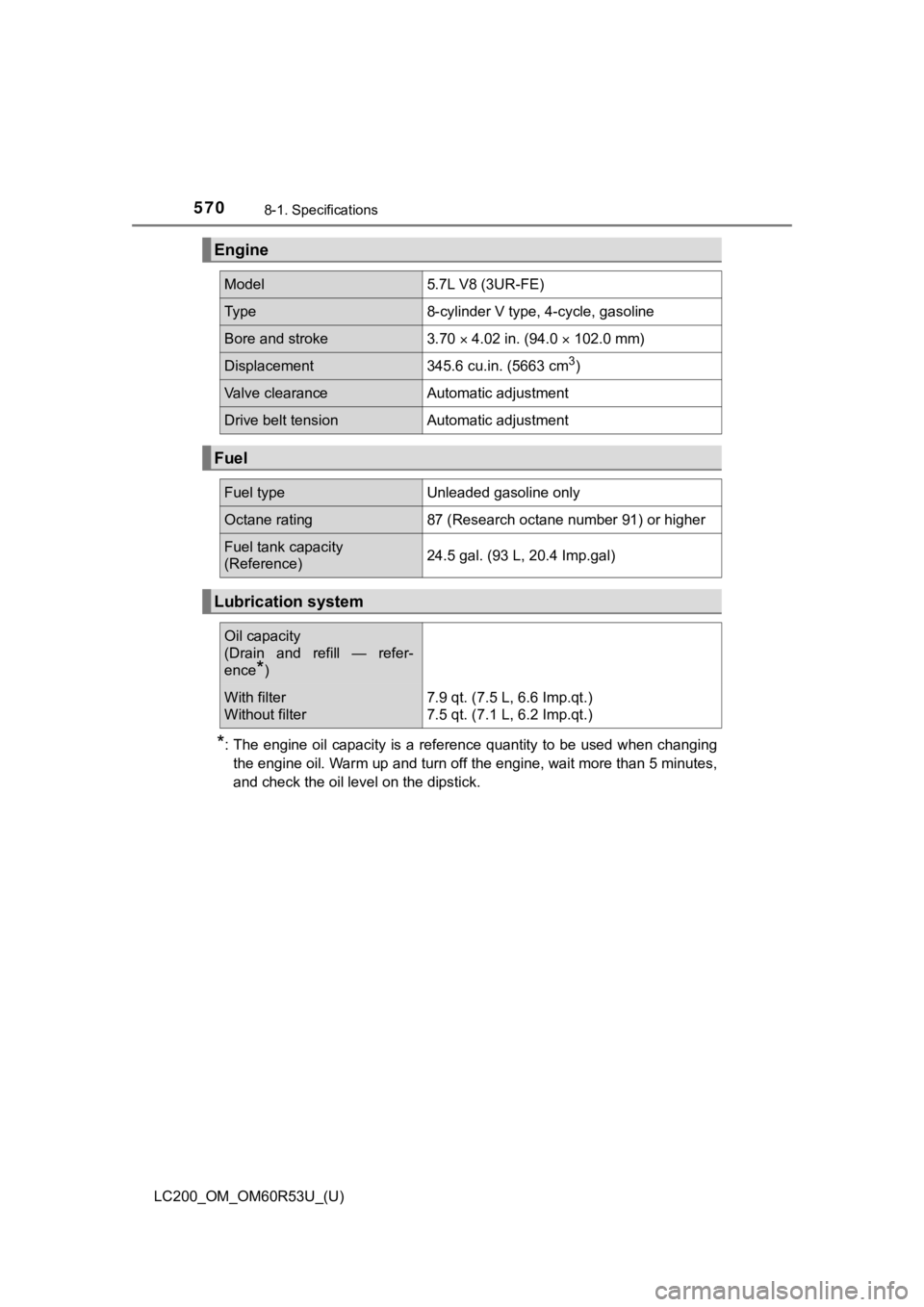TOYOTA LAND CRUISER 2020 Owners Manual (in English)
LAND CRUISER 2020
TOYOTA
TOYOTA
https://www.carmanualsonline.info/img/14/42600/w960_42600-0.png
TOYOTA LAND CRUISER 2020 Owners Manual (in English)
Trending: radio antenna, battery replacement, spare wheel, warning light, oil filter, fuse box, spark plugs
Page 561 of 628
561
LC200_OM_OM60R53U_(U)
7
When trouble arises
7-2. Steps to take in an emergency
If your vehicle overheats
Stop the vehicle in a safe place and turn off the air conditioning sys-
tem, and then stop the engine.
If you see steam:
Carefully lift the hood after the steam subsides.
If you do not see steam:
Carefully lift the hood.
After the engine has cooled down sufficiently, inspect the hoses and
radiator core (radiat or) for any leaks.
Radiator
Cooling fans
If a large amount of coolant
leaks, immediately contact your
Toyota dealer.
The following may indicate that your vehicle is overheating.
● The needle of the engine c oolant temperature gauge (P. 93)
enters the red zone or a loss of engine power is experienced. ( For
example, the vehicle s peed does not increase.)
● Steam is coming from under the hood.
Correction procedures
1
2
3
1
2
Page 562 of 628
5627-2. Steps to take in an emergency
LC200_OM_OM60R53U_(U)
The coolant level is satisfactory if it is between the “F” and “L” lines
on the reservoir.
Reservoir
“F”
“L”
Radiator cap
Add coolant if necessary.
Water can be used in an emer-
gency if coolant is unavailable.
Start the engine and turn the ai r conditioning system on to check
that the air conditioning condenser cooling fans operate and to
check for coolant l eaks from the radiator or hoses.
The fans operate when the air conditioning system is turned on immedi-
ately after a cold start. Confirm that the fans are operating b y checking the
fan sound and air flow. If it is difficult to check these, turn the air condition-
ing system on and off repeatedly.
(The fans may not operate in freezing temperatures.)
If the fans are not operating:
Stop the engine immediately and contact your Toyota dealer.
If the fans are operating:
Have the vehicle ins pected at the nearest Toyota dealer.
4
1
2
3
4
5
6
7
Page 563 of 628
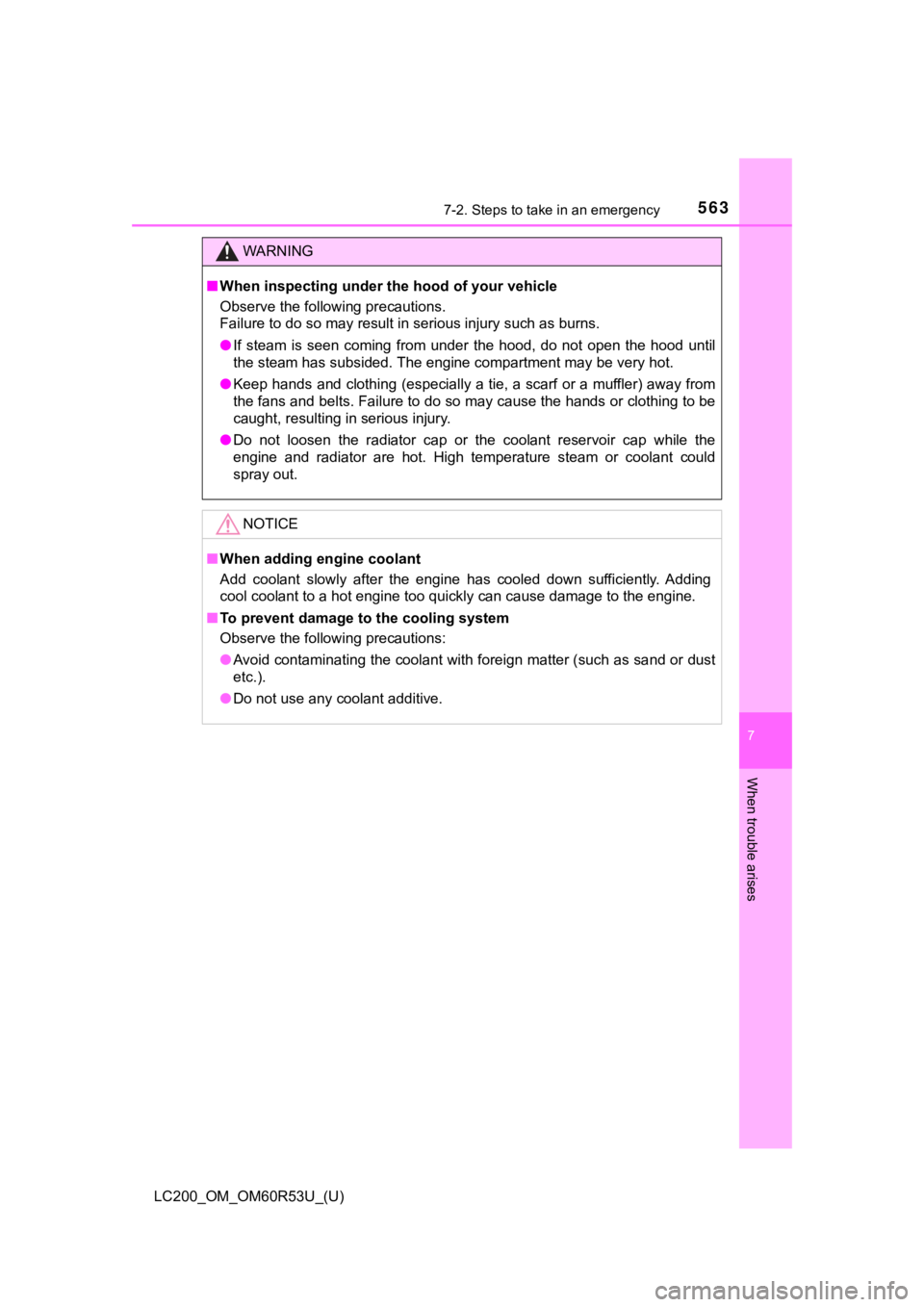
5637-2. Steps to take in an emergency
LC200_OM_OM60R53U_(U)
7
When trouble arises
WARNING
■When inspecting under th e hood of your vehicle
Observe the following precautions.
Failure to do so may result in serious injury such as burns.
● If steam is seen coming from under the hood, do not open the ho od until
the steam has subsided. The engine compartment may be very hot.
● Keep hands and clothing (especially a tie, a scarf or a muffler ) away from
the fans and belts. Failure to do so may cause the hands or clothing to be
caught, resulting in serious injury.
● Do not loosen the radiator cap or the coolant reservoir cap whi le the
engine and radiator are hot. High temperature steam or coolant could
spray out.
NOTICE
■ When adding engine coolant
Add coolant slowly after the engine has cooled down sufficientl y. Adding
cool coolant to a hot engine too quickly can cause damage to th e engine.
■ To prevent damage to the cooling system
Observe the following precautions:
● Avoid contaminating the coolant with foreign matter (such as sa nd or dust
etc.).
● Do not use any coolant additive.
Page 564 of 628
564
LC200_OM_OM60R53U_(U)
7-2. Steps to take in an emergency
If the vehicle becomes stuck
Stop the engine. Set the parking brake and shift the shift lever to P.
Remove the mud, snow or sand from around the rear wheels.
Place wood, stones or some other material under the rear wheels
to help provide traction.
Restart the engine.
Shift the shift lever to the D or R position and release the pa rking
brake. Then, while exercising c aution, depress the accelerator
pedal.
■ When it is difficult to free the vehicle
Carry out the following procedures if the tires spin or the vehicle
becomes stuck in mud, dirt, or snow:
Press to turn off Active TRAC.
1
2
3
4
5
Page 565 of 628
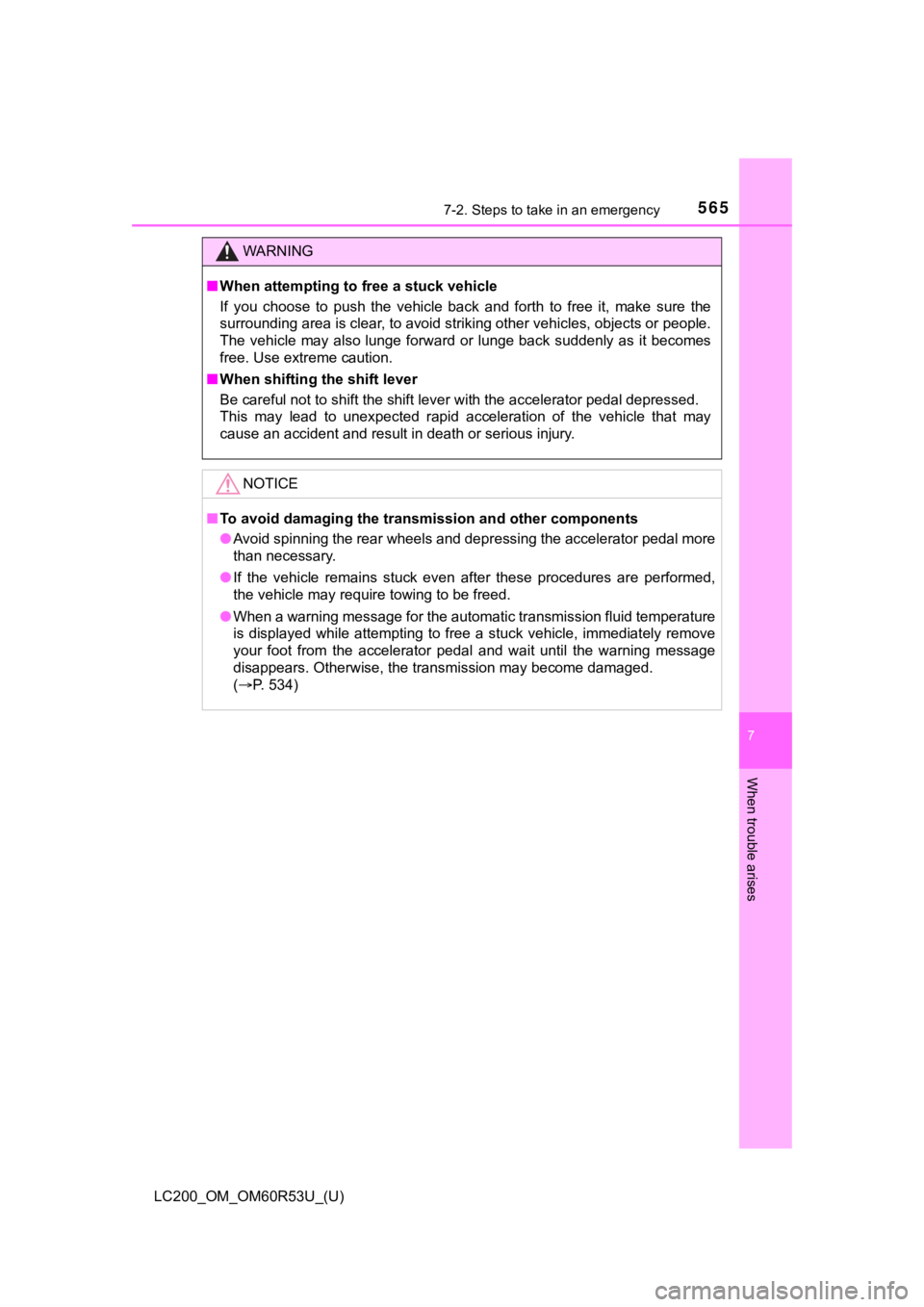
5657-2. Steps to take in an emergency
LC200_OM_OM60R53U_(U)
7
When trouble arises
WARNING
■When attempting to f ree a stuck vehicle
If you choose to push the vehicle back and forth to free it, ma ke sure the
surrounding area is clear, to avoid striking other vehicles, ob jects or people.
The vehicle may also lunge forward or lunge back suddenly as it becomes
free. Use extreme caution.
■ When shifting the shift lever
Be careful not to shift the shift lever with the accelerator pedal depressed.
This may lead to unexpected rapid acceleration of the vehicle t hat may
cause an accident and result in death or serious injury.
NOTICE
■ To avoid damaging the transmission and other components
● Avoid spinning the rear wheels and depressing the accelerator p edal more
than necessary.
● If the vehicle remains stuck even after these procedures are pe rformed,
the vehicle may require towing to be freed.
● When a warning message for the automatic transmission fluid tem perature
is displayed while attempting to free a stuck vehicle, immediat ely remove
your foot from the accelerator pedal and wait until the warning message
disappears. Otherwise, the transmission may become damaged.
( P. 534)
Page 566 of 628
5667-2. Steps to take in an emergency
LC200_OM_OM60R53U_(U)
Page 567 of 628
567
LC200_OM_OM60R53U_(U)
8Vehicle specifications
8-1. SpecificationsMaintenance data (fuel, oil level, etc.) .......... 568
Fuel information ................ 576
Tire information ................. 579
8-2. Customization Customizable features ...... 590
8-3. Initialization Items to initialize ............... 602
Page 568 of 628
568
LC200_OM_OM60R53U_(U)
8-1. Specifications
Maintenance data (fuel, oil level, etc.)
*1: Unladen vehicle
*2: Vehicles without roof rail and cross rail
*3: Vehicles with roof rail and cross rail
Dimensions and weights
Overall length196.5 in. (4990 mm)
Overall width78.0 in. (1980 mm)
Overall height*174.0 in. (1880 mm)*2
76.2 in. (1935 mm)*3
Wheelbase112.2 in. (2850 mm)
TreadFront65.0 in. (1650 mm)
Rear64.8 in. (1645 mm)
Vehicle capacity weight
(Occupants + luggage)1320 lb. (600 kg)
TWR (trailer weight +
cargo weight)With brake8100 lb. (3675 kg)
Without
brake1000 lb. (454 kg)
Page 569 of 628
LC200_OM_OM60R53U_(U)
5698-1. Specifications
8
Vehicle specifications
■Vehicle identification number
The vehicle identification number (VIN) is the legal identifier for
your vehicle. This is the primary identification number for you r
Toyota. It is used in registeri ng the ownership of your vehicle .
This number is stamped on the
top left of the instrument panel.
This number is also on the Cer-
tification Label.
■Engine number
The engine number is stamped
on the engine block as shown.
Vehicle identification
Page 570 of 628
570
LC200_OM_OM60R53U_(U)
8-1. Specifications
*: The engine oil capacity is a reference quantity to be used when changing
the engine oil. Warm up and turn off the engine, wait more than 5 minutes,
and check the oil level on the dipstick.
Engine
Model5.7L V8 (3UR-FE)
Ty p e8-cylinder V type, 4-cycle, gasoline
Bore and stroke3.70 4.02 in. (94.0 102.0 mm)
Displacement345.6 cu.in. (5663 cm3)
Valve clearanceAutomatic adjustment
Drive belt tensionAutomatic adjustment
Fuel
Fuel typeUnleaded gasoline only
Octane rating87 (Research octane number 91) or higher
Fuel tank capacity
(Reference)24.5 gal. (93 L, 20.4 Imp.gal)
Lubrication system
Oil capacity
(Drain and refill — refer-
ence
*)
With filter
Without filter7.9 qt. (7.5 L, 6.6 Imp.qt.)
7.5 qt. (7.1 L, 6.2 Imp.qt.)
Trending: coolant reservoir, climate control, fuel pump, height, overheating, keyless, weight
